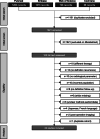Radiological prognostic factors of chronic subdural hematoma recurrence: a systematic review and meta-analysis
- PMID: 33094383
- PMCID: PMC7803717
- DOI: 10.1007/s00234-020-02558-x
Radiological prognostic factors of chronic subdural hematoma recurrence: a systematic review and meta-analysis
Erratum in
-
Correction to: Radiological prognostic factors of chronic subdural hematoma recurrence: a systematic review and meta-analysis.Neuroradiology. 2021 Jan;63(1):159-160. doi: 10.1007/s00234-020-02597-4. Neuroradiology. 2021. PMID: 33151355 Free PMC article. No abstract available.
Abstract
Purpose: Chronic subdural hematoma (CSDH) is associated with high recurrence rates. Radiographic prognostic factors may identify patients who are prone for recurrence and who might benefit further optimization of therapy. In this meta-analysis, we systematically evaluated pre-operative radiological prognostic factors of recurrence after surgery.
Methods: Electronic databases were searched until September 2020 for relevant publications. Studies reporting on CSDH recurrence in symptomatic CSDH patients with only surgical treatment were included. Random or fixed effects meta-analysis was used depending on statistical heterogeneity.
Results: Twenty-two studies were identified with a total of 5566 patients (mean age 69 years) with recurrence occurring in 801 patients (14.4%). Hyperdense components (hyperdense homogeneous and mixed density) were the strongest prognostic factor of recurrence (pooled RR 2.83, 95% CI 1.69-4.73). Laminar and separated architecture types also revealed higher recurrence rates (RR 1.37, 95% CI 1.04-1.80 and RR 1.76 95% CI 1.38-2.16, respectively). Hematoma thickness and midline shift above predefined cut-off values (10 mm and 20 mm) were associated with an increased recurrence rate (RR 1.79, 95% CI 1.45-2.21 and RR 1.38, 95% CI 1.11-1.73, respectively). Bilateral CSDH was also associated with an increased recurrence risk (RR 1.34, 95% CI 0.98-1.84).
Limitations: Limitations were no adjustments for confounders and variable data heterogeneity. Clinical factors could also be predictive of recurrence but are beyond the scope of this study.
Conclusions: Hyperdense hematoma components were the strongest prognostic factor of recurrence after surgery. Awareness of these findings allows for individual risk assessment and might prompt clinicians to tailor treatment measures.
Keywords: CSDH; CT; Chronic subdural hematoma; Predictors; Recurrence.
Conflict of interest statement
The authors declare that they have no conflict of interest.
Figures





References
-
- Almenawer SA, Farrokhyar F, Hong C, Alhazzani W, Manoranjan B, Yarascavitch B, Arjmand P, Baronia B, Reddy K, Murty N, Singh S. Chronic subdural hematoma management: a systematic review and meta-analysis of 34,829 patients. Ann Surg. 2014;259:449–457. doi: 10.1097/SLA.0000000000000255. - DOI - PubMed
-
- Trotter W. Chronic subdural hemorrhage of traumatic origin and its relation to pachymeningitis haemorhhagica interna. Br J Surg. 1914;2:271–291. doi: 10.1002/bjs.1800020608. - DOI
-
- Bosche B, Molcanyi M, Noll T, Kochanek M, Kraus B, Rieger B, el Majdoub F, Dohmen C, Löhr M, Goldbrunner R, Brinker G. Occurrence and recurrence of spontaneous chronic subdural haematoma is associated with factor XIII deficiency. Clin Neurol Neurosurg. 2013;115:13–18. doi: 10.1016/j.clineuro.2012.03.045. - DOI - PubMed
Publication types
MeSH terms
LinkOut - more resources
Full Text Sources
Medical

